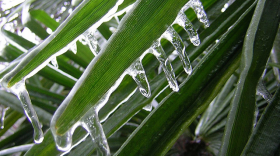When Dr. Athena Masson was 3 years old, Hurricane Andrew devastated her South Beach community. She remembers hearing meteorologist Bryan Norcross on the radio, telling listeners they were evacuating the TV station. She remembers him saying, 'You need to find a mattress and put it over your head, and that mattress is going to save you.'
Rescue workers later found her and her mother--under a mattress. Masson made a commitment to herself, at that young age, to do her best to prevent something like that from happening ever again.
That was in 1992, and a lot has changed with our climate since then. But Masson's commitment hasn't. She’s developed a new and improved scale to measure and rate hurricanes in the North Atlantic Basin. The Masson-Gough Hurricane Scale revolutionizes how hurricanes are classified--and might just change how we understand them.
When Hurricane Katrina came ashore in Louisiana it was a Category 3. Storm surge for a Category 3, Masson notes, should only be at 9-12 feet. Katrina's surge was more than double that, at 25-28 feet above normal tide levels. Considering the deaths and destruction it left behind, Masson notes Katrina should have been classified as a Cat 4 or Cat 5.
But, the scale used to calculate the category of a hurricane, the Saffir-Simpson scale, introduced in 1973, is based only on wind.
It's worth noting the Saffir-Simpson scale did include barometric pressure and storm surge through 2010--but when the system failed to accurately assess Katrina and Ike, those calculations were eliminated rather than re-worked, and today are considered separate from the category system. Followers of weather noted that National Hurricane Center warnings for Hurricane Laura, a Cat 4, included "unsurvivable" storm surge warnings.
When Hurricane Sandy came ashore in 2012 as a Category 1, the wind speeds were weak. But the flooding, storm surge and rain were devastating. The bigger a storm, Masson points out, the more water is pushed ashore. Sandy was weak, yet massive in size.
That means more than 80% of hurricane fatalities are caused by water. "Water is the main killer. There is no denying that fact," says Masson, now meteorologist for Florida Storms and the Florida Public Radio Emergency Network (FPREN). "Yet we're focused on the wind. At the end of the day, we're trying to save lives."
The Masson-Gough Scale takes water into account as part of the more complete big picture, which looks at 6 components: wind; barometric pressure; storm surge; size of the system; moisture content within the storm; and forward speed. Each component is assigned a number on a scale of 0-7, with zero being weak and 7 being "Hollywood apocalyptic level," destruction, Masson explains. Those numbers are added up and converted back to a category-based scale--the numbers, Category 1, 2, 3 etc. are still the same. The difference is each component of the hurricane is considered and evaluated on its own.
The Masson-Gough Scale classified Sandy as a Category 3--but the National Weather Service does not use this model. The Masson-Gough Scale is used in the academic realm for analysis, and it is used in parts of Atlantic Canada.
Mason says the back to back hurricanes we’re seeing this season, are a harbinger of climate change and rising water levels. Masson also notes there is no doubt we will be seeing more hurricanes as water temperatures continue to rise.
The Gulf, she notes, is at 80 degrees or higher for most of the year now. “If climate change continues... we might have a year-long [hurricane] season similar to the Pacific. This could become the story in the North Atlantic.”
"I like living along the coast. I like waking up on the ocean. I don't think people will like or follow my advice of moving 10-20 miles inland. I'm not listening to my own advice either," she notes.
"Mother Nature will always win at the end of the day," Masson adds.
She also has a lesson from her own hurricane survival story, learned when she was still a toddler: "Trust your local meteorologist and keep a radio handy."







